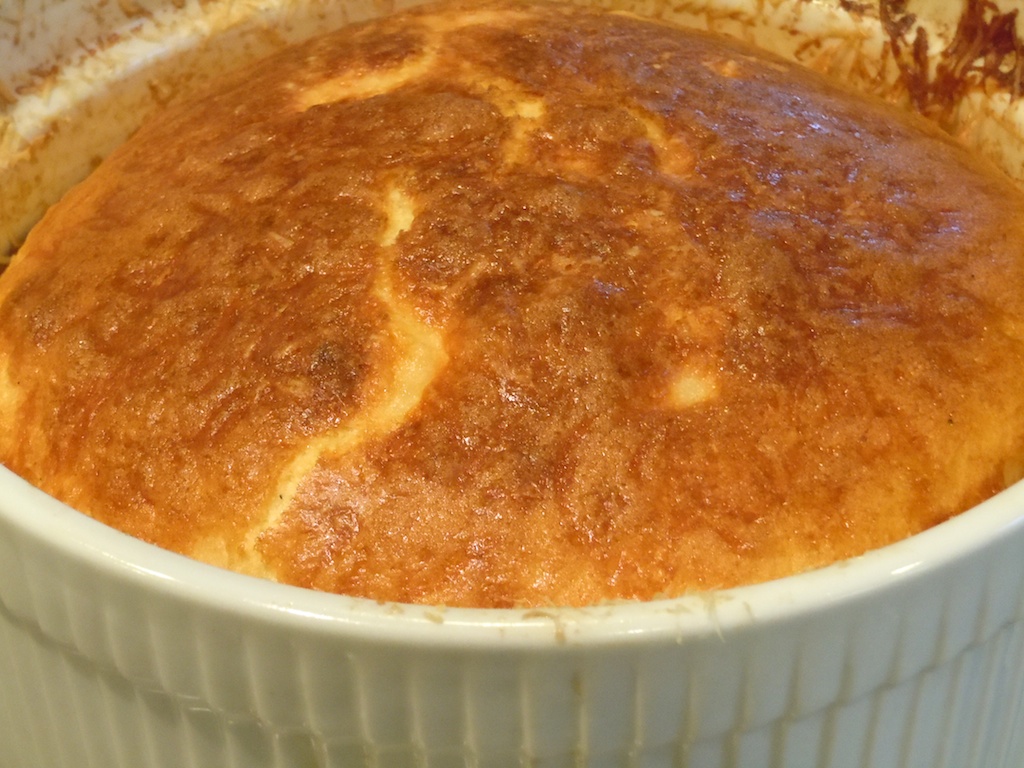 Should the first soufflé you’ve ever eaten be the one you made yourself? Should the first soufflé you’ve ever made be served to anyone other than you and perhaps one other trusted friend? I’ll have to say “yes” to both questions, as my experience with soufflé — long on my list of culinary to-dos — was a success, thankfully, but my intensity toward ensuring its success should be witnessed by no others than myself and my trusted friend. I’ll make soufflé for guests next time. And I’ll be much more calm while doing it.
Should the first soufflé you’ve ever eaten be the one you made yourself? Should the first soufflé you’ve ever made be served to anyone other than you and perhaps one other trusted friend? I’ll have to say “yes” to both questions, as my experience with soufflé — long on my list of culinary to-dos — was a success, thankfully, but my intensity toward ensuring its success should be witnessed by no others than myself and my trusted friend. I’ll make soufflé for guests next time. And I’ll be much more calm while doing it.
Because soufflé, as hoitey and sophisticated as it seems, is completely do-able for the average cook (I can say that now in retrospect). I used to believe soufflés were two things — too retro, a days-gone-by dish best left in the past like a turkey tetrazzinni or a salmon mousse; and too complex, like a flambé or a baked Alaska, best left on the restaurant menu and never contemplated in the home kitchen.
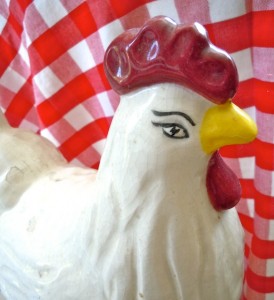 How wrong I was. And the more I watched soufflés being pulled out of ovens on any number of cooking shows, their puffy loftiness, jiggling and dancing all the way, I became hungrier and hungrier, not only for the taste, but for the challenge.
How wrong I was. And the more I watched soufflés being pulled out of ovens on any number of cooking shows, their puffy loftiness, jiggling and dancing all the way, I became hungrier and hungrier, not only for the taste, but for the challenge.
As spring and Easter arrived, and every young blogger’s fancy turned toward thoughts of eggs, naturally, I considered what egg dishes I might try. This is the year of living fully (remember “if you’re going to try, go all the way…”), so I leapt to the height of my egg aspirations and decided to go full throttle toward a soufflé.
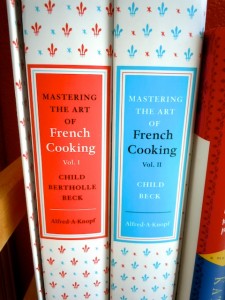 There was no question as to whose soufflé I would make. I realize I’m not the only blogger (but may be the last blogger) to pay homage to the Soufflé au Fromage recipe from Julia Child, but, better late than never. I was a fan of Julia when I was a child, delighting in her enthusiasm, her disregard for being polished, and the moist sounds that came from her mouth as she talked, making me believe her cooking came not only from a place of heart, but of hunger. A while back, I bought the two-volume set of her Mastering the Art of French Cooking (2 Volume Set)
There was no question as to whose soufflé I would make. I realize I’m not the only blogger (but may be the last blogger) to pay homage to the Soufflé au Fromage recipe from Julia Child, but, better late than never. I was a fan of Julia when I was a child, delighting in her enthusiasm, her disregard for being polished, and the moist sounds that came from her mouth as she talked, making me believe her cooking came not only from a place of heart, but of hunger. A while back, I bought the two-volume set of her Mastering the Art of French Cooking (2 Volume Set)
. The soufflé would be the first recipe from the books that I would try.
The book’s soufflé section is extensive, with very detailed directions, as one would expect them to be. Great attention is paid to how one can successfully beat egg whites to sufficient stiffness, what constitutes a proper soufflé mold, how one properly folds the fluffy egg whites into the cheese and egg sauce prior to baking. The recipes offered in the book are main dish versions, which is where I wanted to head for my first time.
A cheese soufflé, or the more elegant title of Soufflé au Fromage, sounded simple and daunting all at once. Reading through the instructions my main contention of dauntabiltiy was timing. One must have the egg whites and base sauce in fit form at the same time and then merge them, unscathed and undefeated, before the whole business is poured into the soufflé dish where, once again the impression of time and heat would render whether the whole thing had worked or not. Only time and timing would tell.
I felt fairly certain I could pull it off. I’m not a chef, but I have a general knowledge of how things should be, culinarily speaking, and I could certainly read and follow instructions.
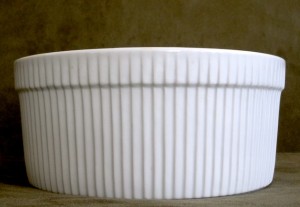 First, my mold. I had the dishes to do individual soufflés, but, ever up for a new kitchen purchase, I bought an inexpensive 8-cup crock.
First, my mold. I had the dishes to do individual soufflés, but, ever up for a new kitchen purchase, I bought an inexpensive 8-cup crock.
Second, my cheese. “Mastering the Art,” recommended Swiss or a combination of Swiss and parmesan (with a dusting of finely grated parmesan to line the buttered mold). Of Swiss cheeses, my heart belongs to Gruyere (until another comes along that can rival). I have used Gruyere in a few dishes now, and the depth and intensity of its pungent flavor and how well it dissolves into and over — upon melting — whatever dish I have prepared, I could only imagine how delicious it would be in a soufflé.
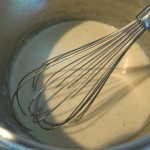 A soufflé goes like this: you make the base sauce, a pale roux of flour and butter into which hot milk, seasonings of salt, pepper, cayenne and nutmeg are added. Then egg yolks — a number of them, depending on how big your soufflé will be — one by one. Then, egg whites (lots of them, well, in my case seven!) are beaten to stiff glossy peaks (no more, no less!).
A soufflé goes like this: you make the base sauce, a pale roux of flour and butter into which hot milk, seasonings of salt, pepper, cayenne and nutmeg are added. Then egg yolks — a number of them, depending on how big your soufflé will be — one by one. Then, egg whites (lots of them, well, in my case seven!) are beaten to stiff glossy peaks (no more, no less!). 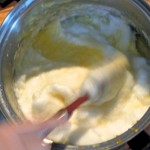 Lighten your egg yolk sauce with some of the whites, then add your cheese, then fold all the egg whites into the rest of the mixture. But don’t fold too much! Don’t collapse it before it’s had a chance to make it to the oven! These exclamations occurred in my head only as I worked with the stern silent tension of a microsurgeon.
Lighten your egg yolk sauce with some of the whites, then add your cheese, then fold all the egg whites into the rest of the mixture. But don’t fold too much! Don’t collapse it before it’s had a chance to make it to the oven! These exclamations occurred in my head only as I worked with the stern silent tension of a microsurgeon.
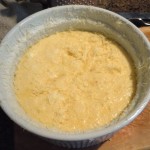 My longtime friend and collaborator, watching all the while (which is truly not always helpful) sensed my tension and told me to relax. I waited until I had pushed my unborn soufflé into the oven before reproaching him. Backseat cooking, particularly when egg whites are held in the balance, is not really appreciated.
My longtime friend and collaborator, watching all the while (which is truly not always helpful) sensed my tension and told me to relax. I waited until I had pushed my unborn soufflé into the oven before reproaching him. Backseat cooking, particularly when egg whites are held in the balance, is not really appreciated.
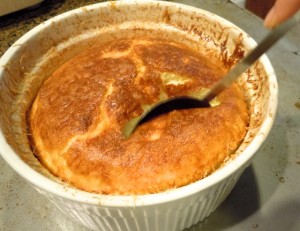 The soufflé bloomed, rising not quite to the top of the mold as had been predicted (had I used more egg whites, it most likely would). It glowed a golden brown. I removed it from the oven and awaited collapse (you’d think AWS would be more positive at this juncture, but well-meaning friends and cookbooks had predicted deflation). It did not, in fact, fall or shrink, even upon digging in. It was delightfully cloudlike in texture, yet still firm, like those thunderclouds on the horizon that I watched in my youth, believing they were solid enough I could climb them like stair steps.
The soufflé bloomed, rising not quite to the top of the mold as had been predicted (had I used more egg whites, it most likely would). It glowed a golden brown. I removed it from the oven and awaited collapse (you’d think AWS would be more positive at this juncture, but well-meaning friends and cookbooks had predicted deflation). It did not, in fact, fall or shrink, even upon digging in. It was delightfully cloudlike in texture, yet still firm, like those thunderclouds on the horizon that I watched in my youth, believing they were solid enough I could climb them like stair steps.
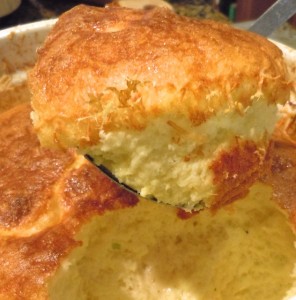 I expected the soufflé to taste something like a puffy omelette. Well that was a low aim. Soufflé, my friends, is unlike anything else. You no longer merely taste eggs; you no longer merely taste cheese. A new species is formed here and there is no other way to suppose it than alchemy (and I have spoken of alchemy here before, but this is it in high form). So soft it melts as it hits the tongue in a delicate but fulfilling richness, a slight chewiness on the surface crusted by a sprinkling of cheese atop. The fork hushes through it with each bite. Truly something special.
I expected the soufflé to taste something like a puffy omelette. Well that was a low aim. Soufflé, my friends, is unlike anything else. You no longer merely taste eggs; you no longer merely taste cheese. A new species is formed here and there is no other way to suppose it than alchemy (and I have spoken of alchemy here before, but this is it in high form). So soft it melts as it hits the tongue in a delicate but fulfilling richness, a slight chewiness on the surface crusted by a sprinkling of cheese atop. The fork hushes through it with each bite. Truly something special.
And here’s one thing no one ever mentions about soufflé. If you have leftovers, as we did, you can refrigerate them and reheat them and the experience is just as good.
We fret so over something we perceive as tenuous and yet…resilience is found in the most seemingly delicate things.
One final contemplation: If a soufflé falls in the oven and no one is there to hear it, does it make a sound? I don’t plan on finding out.
Soufflé au Fromage
(Cheese Soufflé)
From “Mastering the Art of French Cooking” by Julia Child, Louisette Bertholle and Simone Beck (1961)
Ingredients
3 tablespoons unsalted butter
1 teaspoon unsalted butter
1 tablespoon swiss cheese or 1 tablespoon parmesan cheese, grated
3 tablespoons flour
1 cup milk, boiling
1/2 teaspoon salt
1/2 teaspoon pepper
cayenne pepper, pinch
nutmeg, pinch
6 egg yolks
salt, pinch
7 egg whites
1 cup parmesan cheese or 1 cup swiss cheese, grated
Preheat oven to 400 degrees.
Measure out all your ingredients. Butter the inside of a 6 cup soufflé mold and sprinkle it with cheese.
Melt the butter in a 1-1/2 quart saucepan. Stir in the flour with a wooden spatula or spoon and cook over moderate heat until butter and flour foam together for 2 minutes without browning. Remove from heat; when the mixture has stopped bubbling, pour in all the boiling milk at once. Beat vigorously with a wire whip until blended. Beat in the seasonings. Return over moderately high heat and boil, stirring with the whip, for 1 minute. Sauce will be very thick.
Remove the sauce from the heat. Immediately start to separate the eggs. Drop the white into the egg white bowl, add the yolk into the center of the hot sauce. Beat the yolk into the sauce with the wire whip.
Continue in the same manner with the rest of the eggs. and beat in well, one at a time. Correct seasoning. (May be prepared ahead to this point. Dot the top of sauce with butter. Heat to tepid before continuing.
Add your egg whites to a clean mixing bowl with a pinch of salt and beat until stiff.
Stir a big spoonful (about one quarter of the egg whites) of the beaten whites into the sauce.
Stir in 1 cup (minus 1 tablespoon) of grated Swiss cheese.
Delicately fold in the rest of the egg whites. Be careful not to overfold! This is a very important step!
Turn the soufflé mixture into the prepared mold, which should be almost 3/4 full. Tap bottom of mold lightly on the table,
and smooth the surface of the soufflé with the flat of a knife.
Sprinkle the remaining cheese on top.
Set on a rack in the middle of a preheated 400 degree oven and immediately turn the heat down to 375 (Do not open the door for 20 minutes).
In 25-30 minutes the soufflé will have puffed about 2 inches over the rim of the mold, and the top will be nicely browned.
Bake 4-5 more minutes to firm it up, then serve at once.